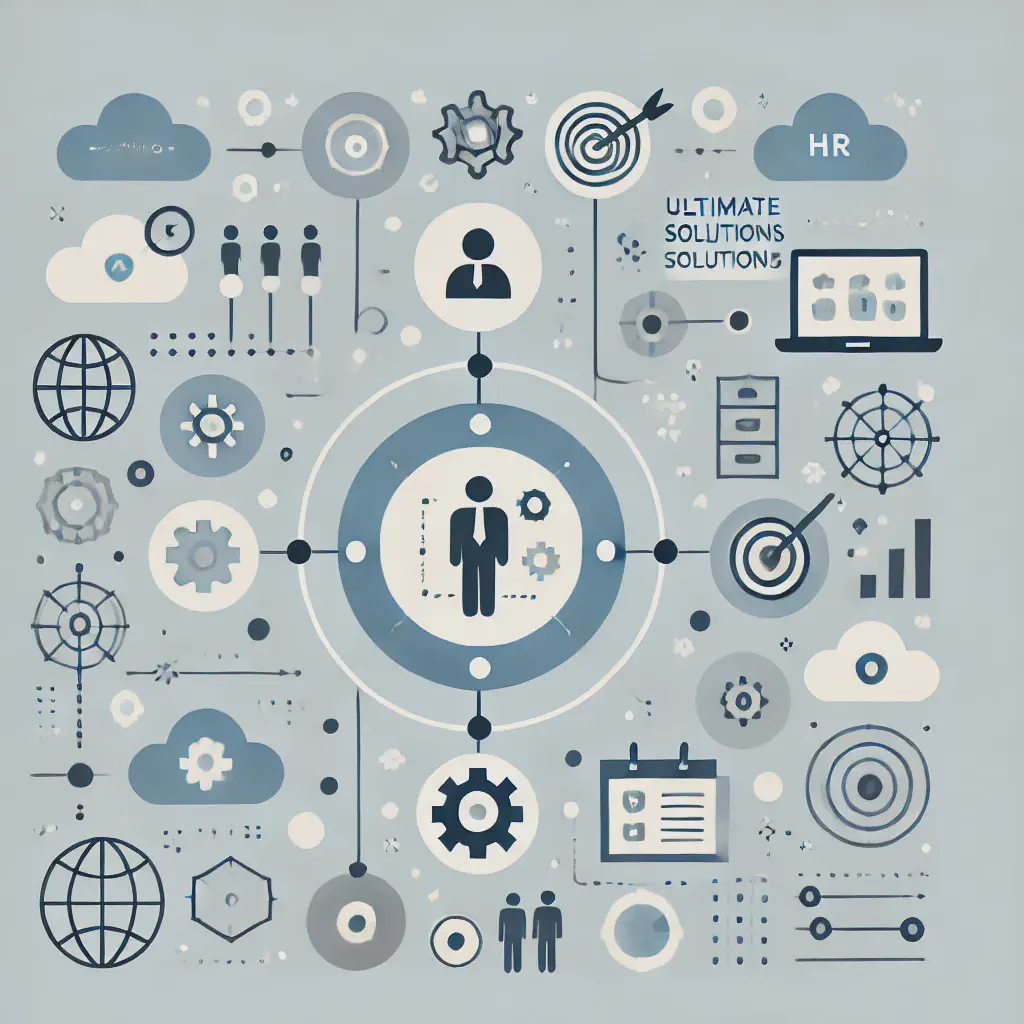
Ultimate HR Solutions: Streamlining Processes with Technology
Are repetitive tasks overwhelming your HR department? Inefficiencies can squander time and increase the chance of errors. With remote work becoming standard and a growing emphasis on project-based roles, it’s crucial to embrace new tools that make your HR team more flexible.
Dive into this blog to uncover fresh, user-friendly tools that can streamline your HR activities, ensuring tasks are performed accurately and in line with current standards. You’ll also find practical tactics for adopting systems that foster smart decision-making, energize your team, and contribute to your company’s progress.
1. Simplified Integration of HRIS
Human Resources Information Systems (HRIS) are vital for streamlining HR processes, ensuring data consistency, and aiding in strategic decision-making. A successful HRIS implementation requires selecting the right system, migrating data smoothly, training HR personnel effectively, and conducting ongoing system evaluations to meet the organization’s changing needs.
System Selection
When choosing an HRIS, it’s like finding the perfect puzzle piece that fits just right within the bigger picture of your organization. You need to consider the system’s scalability, compatibility with existing systems, and feature set to ensure it addresses your specific needs. Think of it as a tailor-made suit – it has to fit your company’s current stature while also allowing room for growth.
Data Migration
Data migration is like relocating to a new home. It requires meticulous planning, careful packing of all the valuable information, and ensuring nothing gets lost in the move. To avoid data mishaps, a clear strategy should be in place, including data cleaning, a thorough audit of the information being transferred, and a backup plan to protect against data loss.
Training HR Staff
Training HR staff on the new system is not just about walking them through the technical aspects; it’s about empowering them to make the most of the technology. By providing comprehensive training, HR professionals can transition from being data entry clerks to strategic partners in the organization. It’s like teaching someone to fish – you’re equipping them with skills that will benefit the company for years to come.
Continuous Monitoring and Refinement
Implementing an HRIS isn’t a set-and-forget affair; think of it as a garden that needs regular tending. Continuous monitoring and refinement ensure the system evolves with the company, much like how a gardener prunes and adjusts plants to promote growth. Regular system reviews, feedback from users, and updates in technology or company structure are all part of nurturing the system to full bloom.
2. Embracing Robotic Process Automation to Enhance HR Efficiency
Robotic Process Automation (RPA) in HR can revolutionize the way we handle repetitive tasks, freeing up valuable time for strategic initiatives. By automating these routine processes, we can shift our focus to areas like employee engagement and strategic planning, which are crucial for organizational growth.
The implementation of RPA requires identifying tasks suitable for automation, selecting the best tools, and upskilling the HR team to manage these new processes.
Identifying Automation Opportunities
To truly harness the power of RPA, it’s important to first pinpoint the rule-based, time-consuming HR tasks that are ripe for automation. For instance, data entry and the onboarding of new employees are tasks that, when automated, can yield significant time savings. By focusing on these areas, HR departments can see a marked improvement in efficiency. Anecdotal evidence from companies that automated their onboarding processes suggests that what used to take hours can now be accomplished in mere minutes.
Selecting the Right RPA Tools
Choosing the right RPA tools is a critical decision that can greatly impact the success of automation in HR. It’s not just about the software’s capabilities, but also its compatibility with your organization’s existing systems and the level of support provided by the vendor.
Data shows that companies that carefully evaluate and select RPA tools based on these criteria tend to achieve higher levels of satisfaction and better ROI from their automation efforts.
Training HR Teams on RPA Management
Once the right RPA tools have been selected, the focus shifts to training the HR team effectively. A well-trained team can manage and monitor RPA processes efficiently, ensuring smooth operation and troubleshooting any issues that arise.
Providing comprehensive training is not just beneficial for the immediate implementation but also empowers the HR staff with new skills that can be applied as the technology evolves.
Monitoring and Refining Automated Processes
The work doesn’t stop at the implementation of RPA; continuous monitoring and refinement of automated processes are vital. This ensures that the automation remains aligned with the organization’s changing needs and continues to operate at peak efficiency.
Companies that regularly review and tweak their RPA systems often report sustained improvements in process efficiency and employee satisfaction.
In summary, integrating RPA in HR can significantly reduce the manual workload, allowing HR professionals to contribute more strategically to the organization. By identifying automation opportunities, selecting the right tools, training the HR team, and continuously refining the processes, companies can create a more efficient and forward-thinking HR department.
3. Leveraging AI for Efficient Recruitment
The transformative power of Artificial Intelligence (AI) in recruitment cannot be overstated. AI streamlines the hiring process by swiftly sorting through applications, efficiently pinpointing top talent, and even conducting initial interviews. This not only accelerates the recruitment cycle but also supports HR teams in making data-driven decisions.
Successful integration of AI tools within existing recruitment frameworks requires targeted training for users and ongoing updates to align with evolving hiring standards.
AI-Powered Resume Screening
An AI system that can sift through resumes and evaluate candidates against job requirements is a colossal time-saver. By employing algorithms that learn from job descriptions and ideal candidate profiles, such systems can shortlist applicants with impressive accuracy.
For instance, a case study by a leading tech company showed that their AI screening tool reduced the shortlisting process time by 75%. Training HR teams to understand the output of these AI tools ensures they can make informed decisions based on the recommendations.
Automated Candidate Ranking
AI excels in ranking candidates by their suitability for a position. It assesses not only the experience and skills but also other attributes that match the company’s culture and job specifics. By drawing on a vast array of data points, AI can highlight candidates who might have been overlooked in manual screening.
To illustrate, a recruitment agency found that using AI for candidate ranking improved their placement success rates by 20%.
AI-Enhanced Candidate Engagement
Utilizing AI for initial candidate interactions, such as chatbots for FAQs or video interviews, can enhance the candidate experience and free up valuable HR time. These AI tools provide consistent communication and can be programmed to give personalized responses based on the candidates’ input.
A testimonial from a satisfied job applicant could underscore the effectiveness of such an approach, emphasizing the convenience and responsiveness of the AI-assisted process.
Regular Updates and Training
For AI recruitment tools to remain effective, they must be updated regularly to reflect changes in job criteria and market conditions. Additionally, HR professionals should receive ongoing training to keep pace with these advancements.
A personal reflection from an HR manager about how continuous learning has empowered their team could resonate with readers and highlight the importance of adaptability in technology implementation.
Ethical Considerations and Bias Mitigation
When deploying AI in recruitment, it’s crucial to consider ethical implications and biases that may arise from algorithmic decision-making. Regular audits of AI systems to check for and correct any biases ensure a fair recruitment process.
Sharing a story about how a company successfully addressed and mitigated bias in their AI recruitment tool can serve as an instructive example for others.
4. Enhancing the Employee Experience with Self-Service Portals
Employee self-service portals transform the HR landscape by empowering employees with direct access to their personal information, pay stubs, time-off requests, and benefits enrollment. This self-management capability not only improves the employee experience but also streamlines HR operations and ensures accurate data handling.
Key steps in implementing these portals include selecting an intuitive platform, integrating it with current systems, educating staff on usage, and providing ongoing support.
Choosing a User-Friendly Platform
Select a platform that is intuitive and easy to navigate, which encourages employee usage and minimizes confusion. Anecdotes from companies that have successfully implemented user-friendly self-service portals can illustrate the benefits and increased adoption rates among employees.
Integration with Existing HRIS
Ensure the chosen platform integrates seamlessly with your current HRIS to maintain data consistency and reduce manual data entry errors. A case study highlighting a successful integration can serve as a blueprint for organizations looking to implement similar solutions.
Educating Employees
Develop a comprehensive training program that demonstrates the portal’s features and benefits. Including testimonials from employees who have become proficient in using the portal can inspire others to engage with the new system.
Ongoing Support and Feedback
Establish a support system for employees who need assistance and create channels for feedback to continuously improve the portal. Sharing personal reflections from the HR team on the challenges and triumphs of supporting employees can provide valuable insights for others in similar situations.
By focusing on these critical aspects, organizations can greatly enhance the efficiency and satisfaction associated with HR processes, fostering a more engaged and self-sufficient workforce.
5. Cloud-Based Collaboration Tools Enhance Workforce Flexibility
Cloud-based collaboration tools are indispensable for modern workplaces, enabling employees to work together from anywhere with real-time document sharing and communication. To fully integrate these platforms, companies should assess various options, choose one that meets security and functionality requirements, provide necessary training, and promote consistent usage.
Evaluating Cloud-Based Platforms
When choosing a cloud-based collaboration platform, security and functionality should be your mantra. I recall a case when a company hastily adopted a platform without proper vetting, leading to significant data breaches. Learn from their mistake: take the time to evaluate different platforms. Consider data encryption, user authentication, and the ability to integrate with existing tools. Your due diligence will pay off in the long run.
Training for Seamless Adoption
Imagine giving someone a high-performance sports car without teaching them to drive it—chaos ensues. Similarly, without proper training, cloud-based tools are just fancy icons on a screen. Statistics show that well-trained teams can improve productivity by up to 20%. Invest in comprehensive training sessions to help employees navigate and maximize the new technology. It’s about transforming the way they work, not just how to use the tools.
Encouraging Regular Use and Internal Promotion
It’s not enough to have the tools; they must be woven into the fabric of our daily work. Encourage adoption through regular use by setting an example from the top—when leaders use these tools, others follow. Use internal promotions, showcase success stories, and make it part of your culture. A tool is only as good as the hands that wield it.
Ensuring Mobile Responsiveness
In a world where we live on our smartphones, if it’s not mobile, it might as well not exist. Ensure that your chosen cloud-based tools are mobile-responsive, catering to the 80% of internet users who operate from mobile devices. A mobile-friendly interface can mean the difference between a smooth workflow and frustrating bottlenecks. It’s about keeping pace with how we live and work today.
Selecting Tools with Integration Capabilities
In the digital age, integration is the watchword. Your cloud-based collaboration tools should integrate well with existing systems. It’s like a team sport where each player must work in unison to score. Integration capabilities allow for a seamless workflow, minimizing the need to switch between applications and improving efficiency. Choose tools that can integrate with your HRIS, CRM, and other critical business systems to create a unified user experience.
6. Digital Learning for Skill Enhancement
In today’s fast-paced work environment, enabling employees with digital learning platforms is essential for continuous skill enhancement and fostering a culture of growth. By selecting the right e-learning software, providing a rich library of courses, and encouraging platform usage with incentives, companies can facilitate personalized and self-paced professional development. Moreover, integrating analytics helps measure the impact of these initiatives, ensuring alignment with organizational goals.
Selecting Suitable E-Learning Software
Choosing the right e-learning platform is paramount. Software that is intuitive, accessible, and offers a variety of interactive content formats is essential. Platforms like LinkedIn Learning, which provide a wide range of courses suited for different skill sets, can be a great starting point for many businesses.
Creating a Comprehensive Course Library
It’s important to develop or curate a library of relevant courses. This ensures that employees have access to the training they need. A mix of custom content addressing specific company processes and industry-standard courses can cater to the diverse learning needs within an organization.
Encouraging Platform Engagement
Motivating employees to use e-learning resources is critical. Incentives such as gamification, recognition, or rewards can make learning a desirable part of company culture. Showcasing success stories of employees who have advanced their careers through e-learning can serve as inspiration.
Harnessing Data and Analytics
Integrating data analytics to monitor engagement and effectiveness of e-learning initiatives can help tailor the learning experience. Tracking progress and feedback allows for the continuous improvement of the learning content and platform.
Fostering a Culture of Learning
Leadership example and regular communication about the importance of professional development are key. Highlighting the role of learning in career advancement and the company’s success can help solidify its value among the workforce.
7. Harnessing Data Analytics for HR Insights
In today’s data-driven world, HR departments can leverage analytics to gain insights into workforce trends and drive strategic decision-making. By integrating analytics software with existing HR Information Systems, HR professionals can utilize data to uncover patterns in productivity and engagement. Furthermore, establishing key metrics and regular reporting practices aligns HR initiatives with broader business objectives, enhancing overall organizational performance.
Implementing Analytics Software
Integrating robust analytics software is the backbone of deriving valuable HR insights. This process involves not only the technical setup but also ensuring that the software is compatible with the HRIS in use. For instance, a retail company after implementing analytics was able to reduce employee turnover by pinpointing root causes and developing targeted retention strategies. Sharing such stories allows organizations to witness the tangible benefits of analytics in action.
Training HR Professionals
Training HR staff to interpret data effectively is crucial. A well-trained team can transform raw data into actionable insights. Personal reflections from HR professionals who have upskilled in data analytics can serve as motivational stories, encouraging others to embrace the learning curve. Expert quotes can also underline the importance of data literacy in HR, reinforcing the value of this skill set.
Establishing Metrics and Reporting
Defining the right metrics and setting up systematic reporting practices is akin to setting the navigational course for a ship. Just as a captain needs a compass, HR professionals require clear metrics to steer towards strategic goals. Case studies highlighting businesses that successfully aligned their HR metrics with company objectives can serve as a blueprint for others to follow, emphasizing the importance of systematic reporting and goal-oriented metrics.
8. Professional Employer Organizations and Technological Efficiency
Professional Employer Organizations (PEOs) provide small and medium-sized businesses with comprehensive HR solutions that streamline processes and offer technology-based efficiencies. By partnering with PEOs, companies can outsource various HR functions such as payroll, benefits administration, and compliance management, allowing them to focus on core business activities. These partnerships are established through co-employment agreements and should be chosen based on the PEO’s technological capabilities and service offerings.
Establishing clear communication channels with the PEO is crucial for a successful collaboration. This strategic move not only mitigates HR-related risks but also leverages expertise and technology to enhance HR functions.
Evaluating Potential PEO Partners
When considering a partnership with a PEO, it’s vital to evaluate their technology offerings against your company’s specific needs. Look for a PEO that provides a robust HRIS system, ensuring data consistency and streamlined HR processes. A good practice is to check for client testimonials or case studies, which can give you insights into the PEO’s track record and the impact of their technology solutions on other businesses.
Negotiating a Co-Employment Agreement
Negotiating a co-employment agreement requires a clear understanding of the services provided by the PEO and how they align with your company’s HR requirements. Ensure that the terms of the agreement are transparent, especially regarding responsibilities, liabilities, and the scope of HR tasks the PEO will manage. Consulting with a legal professional can help safeguard your interests and set the foundation for a fruitful partnership.
Establishing Communication Channels
Clear and effective communication is the backbone of any successful partnership. It’s essential to establish dedicated channels for regular updates, queries, and feedback between your business and the PEO. This could involve regular meetings, shared digital platforms, or direct lines to account managers. Such open communication ensures that any issues are promptly addressed and that the collaboration remains aligned with your business objectives.
9. Mobile HR Solutions for On-the-Go Access
Mobile HR solutions are transforming how employees interact with HR services, offering the convenience to manage tasks from anywhere at any time. Ensuring that HR systems are mobile-responsive should be a priority, and selecting tools with mobile usability in mind is crucial. Training and support are necessary to encourage the adoption of mobile solutions, ultimately fostering a more flexible and efficient work environment.
Ensuring Mobile Responsiveness of HRIS and Portals
A mobile-responsive HRIS and self-service portals are essential for employees who need access to HR services on the go. To ensure these platforms are effectively mobile-responsive, conduct thorough testing on various devices and make adjustments as needed. Anecdotes from employees who’ve experienced the ease of mobile access can serve as powerful endorsements of the system’s convenience.
Selecting Tools with Mobile Usability
When choosing new HR tools, prioritize mobile usability to facilitate easy access and enhance user experience. Look for intuitive interfaces and features that simplify mobile interactions. Including testimonials from users who have benefited from the mobile-friendly design can underscore the tool’s value and encourage broader adoption.
Training and Support for Mobile Solutions
Effective training and ongoing support are crucial for successful adoption of mobile HR solutions. Develop concise, easy-to-follow guides and offer hands-on training sessions to help employees become proficient with the new mobile tools. Personal reflections on the positive impact of mobile solutions on daily tasks can help motivate employees to embrace the technology.
10. Developing a Digital HR Strategy
Developing a sound Digital HR Strategy is essential for aligning technological advancements with business goals. This involves a comprehensive analysis of existing systems, identifying shortcomings, and plotting a deliberate path towards tech-enhanced HR operations. Critical to this are engaging key players, setting clear objectives with measurable indicators, and revisiting the strategy regularly to ensure its continued relevance and effectiveness.
Engaging Key Stakeholders
Securing the support of key stakeholders is crucial when embarking on your digital transformation. These champions provide insight and drive your project forward. By involving department leads, for instance, the strategy becomes more tailored to address specific team challenges. Ongoing dialogue through meetings and workshops promotes shared ownership of the digital HR vision.
Defining Clear Objectives and Metrics
A successful strategy must have well-defined targets and benchmarks. Determine the outcomes you wish to achieve through HR technology, such as heightened employee contentment, more efficient operations, or advanced data analytics. Establish concrete metrics to gauge your progress, like aiming for a 20% reduction in hiring times over a six-month period.
Regular Strategy Reviews
In the fluid landscape of business, your Digital HR Strategy must be equally adaptable. Routine evaluations keep your strategy pertinent and operational. Consider these reviews as strategic health checks, assessing the current state, identifying issues, and adjusting plans as needed to ensure enduring success in a technologically evolving environment. As we draw this exploration of Ultimate HR Solutions to a close, the path ahead is clear: it’s time to harness the power of technology and transform your HR processes. But, don’t let the breadth of information overwhelm you.
Start small, pick one aspect of your HR strategy that you know could benefit from a technological upgrade. Perhaps it’s the recruitment process, employee engagement, or data analytics. Identify the key stakeholders, set a measurable goal, and take that first, decisive step towards digital transformation.
Challenge yourself to initiate this change today, not tomorrow. Remember, even the most ambitious digital strategy begins with a single action. Seize this moment to stretch your boundaries and grow—not just as an HR professional, but as a visionary leader in your organization.





